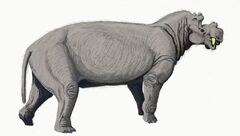| Uintatherium Temporal range: Middle Eocene | |
|---|---|

| |
| A restoration of Uintatherium anceps | |
| Scientific classification | |
| Kingdom: | Animalia |
| Phylum: | Chordata |
| Class: | Mammalia |
| Order: | †Dinocerata |
| Family: | †Uintatheriidae |
| Genus: | †Uintatherium Leidy, 1872 |
| Referred species | |
| |
| Synonyms | |
| |
Uintatherium, (meaning "Beast of the Uinta Mountains") is an extinct genus of mammal that lived during the Eocene epoch, which includes a single species currently recognized, U. anceps. They were similar to today's rhinoceros both in size and in shape, although they are not closely related. Their fossils are the largest and most impressive of the finds at the excavation of Fort Bridger in Wyoming, and were a focal point of the Bone Wars between Othniel Charles Marsh and Edward Drinker Cope. Fossils have been found in both Wyoming and in Utah near the Uinta Mountains, to which the animal owes its name. It appeared in the early Eocene 52 million years ago and lived in the region that is now the American Southwest.
Uintatherium was a large browsing animal. Its most unusual feature was the skull, which is both large and strongly built, but simultaneously flat and concave: this feature is rare and not regularly characteristic of any other known mammal except in some brontotheres. Its cranial cavity was exceptionally small due the walls of the cranium being exceedingly thick. The weight of the skull was mitigated by numerous sinuses permeating the walls of the cranium, like those in an elephant's skull.
The large upper canines might have acted as formidable defensive weapons, and superficially resembled the canines of sabre tooth cats. Sexually dimorphic, the teeth were larger in males than in females. However they also might have used them to pluck the aquatic plants from marshes that seem to have comprised their diet. The skulls of the males bore six prominent knob-like ossicones which grew from the frontal region of the skull. The function of these structures is unknown. They may have been of use in defense and/or sexual display. Uintatherium went extinct about 37 million years ago, presumably due to climate change and competition with perissodactyls such as brontotheres and rhinos.
A cast of a Uintatherium skeleton is on display at the Utah Field House of Natural History State Park. Uintatherium was an extinct genus of large, hoofed mammals found as fossils in North America and Asia in terrestrial deposits that date from the middle of the Eocene Epoch (55.8–33.9 million years ago). The size of a modern rhinoceros, Uintatherium was among the largest animals of its time. The limbs were strongly constructed to support the massive body. Three pairs of bony growths, or protuberances, were present on the skull, and the anterior pair may have supported prominent horns. The teeth were also distinctive: males of the genus possessed large, powerful canines; incisors were absent in the upper jaw but present in the lower jaw.
In The Media
- Uintatherium was featured in a Nissan Cup Noodle commercial & was animated by the Chiodo Bros.
- Some Uintatherium made a few appearances in the 2008 animated film TUROK SON OF STONE.
